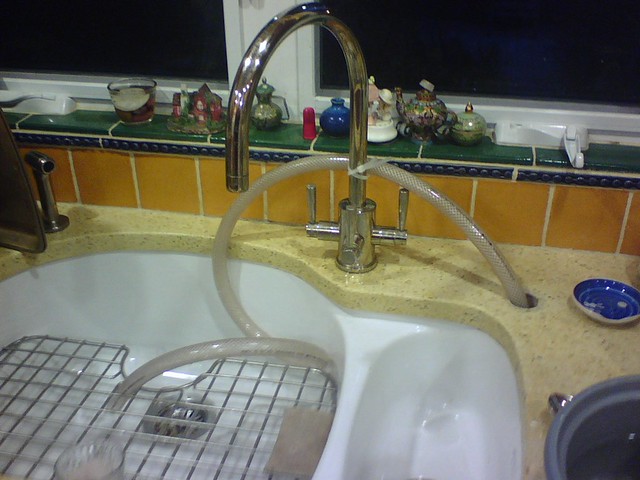Last night, Carol called to me from the bathroom: “Our heat pump water heater isn’t heating!” Yep, we had one of those installed. You know, those things that run like a refrigerator in reverse? I still remember your explaining to me how the freon or whatever gets compressed and heated, then sprays into the part of the system inside the fridge, cooling everything. I also remember your telling me that I didn’t know how lucky I was, and you were right—I didn’t. But what I'm thinking of now is how lucky I was to have you as my father.
Anyway, I ran out to the patio, where the heat-pump water heater is, and opened the door to its closet. It was dark, where usually a LCD display shows what it's set to. H’m. I went to the subpanel in the house. The breaker had been tripped—I wondered why. I switched it to ON and immediately heard arcing. Oh no! I quickly turned it off. Why…?
The cover had one screw mostly off? Oh, the sheetrock guy had to remove the cover in order to put the wallboard on. There was joint compound around the edges, too. Right, the bathroom project still isn’t finished. Yes, we’re using a contractor. Unlike you, I don’t do all this stuff myself any more.
I looked closely at the breaker—was it a little cockeyed? It would be easy to accidentally jostle it while removing or replacing the cover.
I pulled out the (30A 240V) pair of breakers, and the one breaker’s “jaws” looked a little too wide; that was somehow unsurprising; it was the one grabbing the, uh, busbar with the dark deposits (from the arcing, I reckon).No bueno. It was already late, was I going to have to run out and find…? Wait—didn’t I have a spare 30A 240V pair of breakers? Last summer? (fall?), when I thought our old oven might have been the victim of a flakey circuit breaker, I spent the $20 on a replacement pair, which I never installed. Good thing, too; the old breakers were just fine, as proven by the new oven’s flawless operation from day one.
And an even better thing: I had a brand-new pair of breakers to use on the heat pump! I made my way to the garage, found the breakers where I’d left them, and examined them to make sure I correctly remembered their rating. 30A—yes! The jaws had equal (to my eye) and narrow widths, and each pair of jaws also had a little bit of, ah, conductive toothpaste—at least that’s what it looked like—to promote solid contact with its busbar.
Now all I had to do was get the wires off the old breakers and onto the new ones. Wow, why are these screws so hard to turn? Was it because I was using a common screwdriver when I should have been using a square-drive? Modern technology! Fortunately, I had an S2 bit for the cordless screwdriver, which I bought just a couple weeks ago for another purpose. Out in the garage, I found the package exactly where I’d left it (wow, I should buy a lottery ticket). I pulled one off the card (I’d bought a pair) and grabbed my multi-driver tool with the appropriate hexagonal hole (a freebie from when I worked at hp over 20 years ago).
Screws sure turn more easily when you have the right blade. Got the wires off the old breakers and onto the new ones. I might have liked to clean the black deposits off the busbar, but nah, I didn’t want to try figuring out what to clean it with (something not made of metal) and besides, what harm would that stuff do? The conductive toothpaste would ensure a good bond.
Engaged the outer edge of the breakers, then pressed the inner edge all the way in. Turned the breaker to “ON.” Outside, I was greeted by glowing digits: 121°. I headed back in to button up.
I didn’t fully tighten the cover screws, since the joint compound wasn’t dry everywhere. Then I texted my general contractor, asking him to please tell the sheetrock guy that I had to replace the breaker, and that's why I had to touch that breaker panel. He’d certainly be able to tell that I touched it, and I wanted him to know why.
Dad, I’m so glad you taught me all the stuff you did. I truly am a lucky man. I just wish I could still pick up the phone and tell you about this little adventure. You’d commiserate with me and laugh (“Are you saying your wife called to you from the shower, and she just wanted you to fix the hot water?”). You’d agree it was a lucky thing I had not gotten around to returning the unused circuit breakers last summer or fall. You’d congratulate me on the quick diagnosis. I sure would have enjoyed all that. But mostly I would have just enjoyed telling you about it, knowing you understood my thought process.
Love you and miss you, Dad.






















































